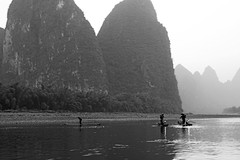 The BBC Wildlife Team broke new ground last night with incredible footage of a Rickett’s Big Footed Bat (Myotis ricketti) hunting fish. Ma et al uncovered the first evidence that this bat was a piscivore in 2003 (Journal of Zoology (2003), 261: 245-248) from analysis of droppings and behavioural observation. This footage is part of the BBC Wild China series which started last night. Both the book from this series, which is out now, and the DVD (to pre-order) are available from NHBS.
The BBC Wildlife Team broke new ground last night with incredible footage of a Rickett’s Big Footed Bat (Myotis ricketti) hunting fish. Ma et al uncovered the first evidence that this bat was a piscivore in 2003 (Journal of Zoology (2003), 261: 245-248) from analysis of droppings and behavioural observation. This footage is part of the BBC Wild China series which started last night. Both the book from this series, which is out now, and the DVD (to pre-order) are available from NHBS.
 The first episode, Heart of the Dragon, focuses on the southern region with it’s iconic terraced paddy fields and the Karst peaks of the Li River. They filmed the ancient technique of Cormorant fishing – which I have seen in action on the Li River – it’s a fascinating collaboration and illustrative of the close working relationship maintained between people and animals in rural Chinese areas. The BBC haven’t shied away from highlighting the staggering conservation challenges facing China and the extent to which a wide range of highly endangered species are exploited.
The first episode, Heart of the Dragon, focuses on the southern region with it’s iconic terraced paddy fields and the Karst peaks of the Li River. They filmed the ancient technique of Cormorant fishing – which I have seen in action on the Li River – it’s a fascinating collaboration and illustrative of the close working relationship maintained between people and animals in rural Chinese areas. The BBC haven’t shied away from highlighting the staggering conservation challenges facing China and the extent to which a wide range of highly endangered species are exploited.
The BBC have summaries of all six episodes as well as lots of behind the scenes detail on the BBC Wild China pages.
If you would like to start observing bats in the wild and listening in on their calls view our range of bat detectors and books about bats.














